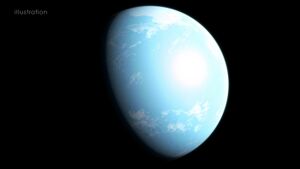Astronomy:Gliese 357 d
 | |
| Discovery | |
|---|---|
| Discovered by | Rafael Luque, Diana Kossakowski |
| Discovery site | TESS |
| Discovery date | 2019 |
| Radial velocity | |
| Orbital characteristics | |
| 0.204±0.015 astronomical unit|AU[1] | |
| Eccentricity | ≈0.033 ± 0.057[2] |
| Orbital period | 55.70±0.05 d[1] |
| Inclination | <40°[2] |
| Star | Gliese 357 |
| Physical characteristics | |
| Mass | 6.1±1.0 M⊕[1] 7.20±1.07 M⊕[2] |
| Physics | 219.6 ± 5.9 K (−53.55 ± 5.90 °C; −64.39 ± 10.62 °F)[1] |
Gliese 357 d is an exoplanet, considered to be a "Super-Earth" within the circumstellar habitable zone of its parent star.[3][4][5][6] The planet orbits Gliese 357, 31 light-years from the Solar System,[4] The system is part of the Hydra constellation.[4]
The planet was discovered by the TESS team and announced in July 2019. The data confirming the presence of the planet was uncovered in ground based observation dating back to 1998 while confirming the TESS detection of Gliese 357 b, a “hot earth” that orbits much closer to the parent star.[6] Even though Gliese 357 d is 20% closer to Gliese 357 than Earth is to the Sun, Gliese 357 is much smaller than the Sun. So it receives as much energy as Mars. As a result it is estimated the average temperature is -64°F (-53°C) but this temperature is survivable for humans, if there is a thick enough atmosphere the actual temperature could be much higher. If humans traveled there using modern spacecraft, it would take them about 660,000 years to get there.[citation needed] The planet is 6 times more massive than Earth and twice Earth's size.[citation needed]
References
- ↑ 1.0 1.1 1.2 1.3 Luque, R.; Pallé, E. et al. (2019). "Planetary system around the nearby M dwarf GJ 357 including a transiting, hot, Earth-sized planet optimal for atmospheric characterization". Astronomy & Astrophysics 628: A39. doi:10.1051/0004-6361/201935801. ISSN 0004-6361. Bibcode: 2019A&A...628A..39L. https://www.aanda.org/articles/aa/full_html/2019/08/aa35801-19/aa35801-19.html.
- ↑ 2.0 2.1 2.2 Jenkins, J S; Pozuelos, F J et al. (2019). "GJ 357: a low-mass planetary system uncovered by precision radial velocities and dynamical simulations". Monthly Notices of the Royal Astronomical Society 490 (4): 5585–5595. doi:10.1093/mnras/stz2937. ISSN 0035-8711.
- ↑ Falconer, Rebecca (2019-08-01). "Newly uncovered super-Earth 31 light-years away may be habitable". https://www.axios.com/super-earth-31-light-years-away-may-support-life-d1d0298d-3c82-4f99-a4af-22774fc1ed70.html.
- ↑ 4.0 4.1 4.2 Reddy, Francis; Center, NASA’s Goddard Space Flight (2019-07-31). "TESS Discovers Habitable Zone Planet in GJ 357 System" (in en-US). https://scitechdaily.com/tess-discovers-habitable-zone-planet-in-gj-357-system/.
- ↑ "Potentially habitable 'super-Earth' discovered just 31 light-years away" (in en). https://www.nbcnews.com/mach/science/potentially-habitable-super-earth-discovered-just-31-light-years-away-ncna1037491.
- ↑ 6.0 6.1 Garner, Rob (2019-07-30). "NASA's TESS Helps Find Intriguing New World". http://www.nasa.gov/feature/goddard/2019/confirmation-of-toasty-tess-planet-leads-to-surprising-find-of-promising-world.
 |



